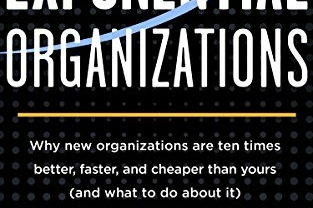Author Marcus Sheridan led his struggling pool company from the bleak depths of the housing crash of 2008 to become one of the largest pool installers in the United States. In They Ask, You Answer: A Revolutionary Approach to Inbound Sales, Content Marketing, and Today’s Digital Consumer, Sheridan describes tactics and insights for developing a great content marketing strategy for businesses.
The core theme of They Ask, You Answer:
Educated prospects become happier, better customers. If your prospects are asking questions, you must answer them — openly and honestly — on your website.
Favorite Takeaways: They Ask, You Answer
“Be the best teacher in the world. Obsess over their questions. Answer with fierce honesty. And win their trust.”
They Ask, You Answer is a business philosophy that guides the sales and marketing approach of an organization through obsessive listening, teaching, and a desire to solve the problems of the marketplace.
They Ask, You Answer is a business philosophy. It’s the willingness to be so focused on and obsessed with consumer questions, wants, desires, and needs that you’re willing to change and evolve your entire business model around these elements.
What is “They Ask, You Answer”?
More than anything, it’s a business philosophy. It’s an approach to communication, company culture, and the way we sell as a business.
“It starts with an obsession: “What is my customer thinking?”
It extends past “What are they thinking?” to “What are they searching, asking, feeling, and fearing?”
When an organization embraces They Ask, You Answer, they believe it’s their duty to be the teacher, the go-to source within their particular industry. One that’s not afraid to answer any and every question the prospect or customer may have. For them, it’s a moral obligation to provide this level of education, regardless of whether the question is perceived as good, bad, or even ugly.
Not only are they willing to address these things better than anyone in their space, but they also allow this to dictate the direction of their business as the future unfolds. Because they are so keenly in tune with what the marketplace is thinking, feeling, and asking, they see where their business model needs to go, evolve, and head toward.
Consumer Buying Shift
Consumer buying patterns have gone through a monumental shift over the past decade. Specifically, the line between “sales” and “marketing” has been completely blurred, if not totally erased.
Have a Brainstorming Session
Brainstorm every question you’ve ever been asked by a prospect or customer. Focus on their fears, issues, concerns, and worries. State them on paper exactly as the buyer would ask (or search) them, not the way you (as the business) would state them.
Understanding consumer fears
Simply put, the greatest companies and modern-day rule makers are obsessed with consumer fear, and they allow that fear to dictate their entire business models. They do this because they know that if they are able to eliminate all fears and negative emotions from the buying process, the only emotion left to feel is trust.
The Big Five
Basically, there were five types of content subjects (or types of questions) that seemed to move the needle with readers more than anything else, ultimately rendering the greatest amount of traffic, conversions, leads, and sales. These five subjects were as follows:
- Pricing and costs
- Problems
- Versus and comparisons
- Reviews
- Best in class
Pricing and Cost
Educate the Customers
In almost every industry, consumers make poor buying decisions and purchase the “cheapest” products and services, not because they are solely price motivated, but rather because they don’t know any better. They haven’t been educated. No one has bothered to truly explain the good, the bad, and the ugly of the industry. And that, once again, is the fault of the business, not the consumer.
Problems: How to Turn Weaknesses into Strengths
When people buy, they worry more about what might go wrong than about what will go right.
Turn Your Problems into Strengths
To start, answer the following two (very related) questions:
- What does the competition say is a negative about the thing we sell?
- What do consumers and buyers see as the negatives of our products and services? (Is it that you’re the most expensive? Is your product only a good fit for certain applications?)
Once you’ve completed this, ask yourself:
- How can we address each of these honestly and transparently on our website and within our sales process to turn it into an advantage?
The moment a business thinks it wants to work with everyone is the moment that business starts to become very, very unhappy. Conversely, one of the happiest moments in the life of any business is the moment that they realize what they are not, and who they are not a good fit for.
The four major fears people experience when giving away their information online:
- They’re afraid the company will abuse their personal information (privacy).
- They’re afraid they’ll be spammed with multiple emails.
- They’re afraid they’ll be bombarded with phone calls from sales reps.
- They’re simply wondering, “What will this process look like if I fill out the form”
A powerful key to eliminating or at least alleviating these fears is achieved by placing a video immediately next to the form that addresses each of these fears
Consumer Journey videos
It’s designed to follow the principle of the “hero’s journey” — something that movie producers and storytellers (like Disney) have used since the beginning of time. The traditional hero’s journey has 12 parts. In the context of a customer journey video, however, this journey can be simplified into three main stages:
- Stage 1: Your customer has a problem — a need, stress, worry, concern, or issue.
- Stage 2: The journey is taken to fix the problem. (In most cases, this is the journey they go on with your company.)
- Stage 3: Where they are today. They were able to fix the problem with your help. (And everyone lived happily ever after.)
The purpose of this video is for a viewer to watch it and say in his or her mind: “They’re just like me. They had the exact problem I have right now, and look how they were able to solve it.”
Conversational Marketing
Conversational marketing refers to the one-to-one conversations buyers have with brands across different channels, whether that’s through live chat, chatbots, Facebook Messenger, Slack, text, and so on. It’s all about making the whole buyer experience of getting answers to questions and, ultimately, making purchases as effortless and friction-free as possible.
Conversational marketing is another example of how brands and companies are being challenged to continually meet their customers where they live — in a digital sense — as our relationship with the internet continues to evolve.
In the digital age, buyers have certain expectations:
- They want it fast.
- They want it personalized.
- They want it to be easy.
And they want to be able to do as much of the buying experience as possible without anyone or anything deterring their efforts. This is the essence of self-selection and self-configuration, and it’s only going to grow in importance for all businesses — B2B, B2C, service, product, etc
Getting the “They Ask, You Answer” philosophy right
- As buyers and consumers, we don’t want to be told what to do or what to buy. Rather, we want to think we’ve educated ourselves enough to arrive at an informed conclusion.
- Put the customers first, produce content that was helpful, and better aid clients in their purchasing decisions.
- Obsessing over customer questions and being willing to answer them better than anyone else in their space.
- Think like a teacher. Obsess not just over the questions, but the way you answer them. This approach will make all the difference.
- Assignment Selling: The process of actively using your content in the sales process.
- We should all be looking for ways to help our prospects become more educated before we talk with them the first time, and then we should continue to educate them throughout the sales process.
Need help with developing a digital strategy for your business? Get in touch.


